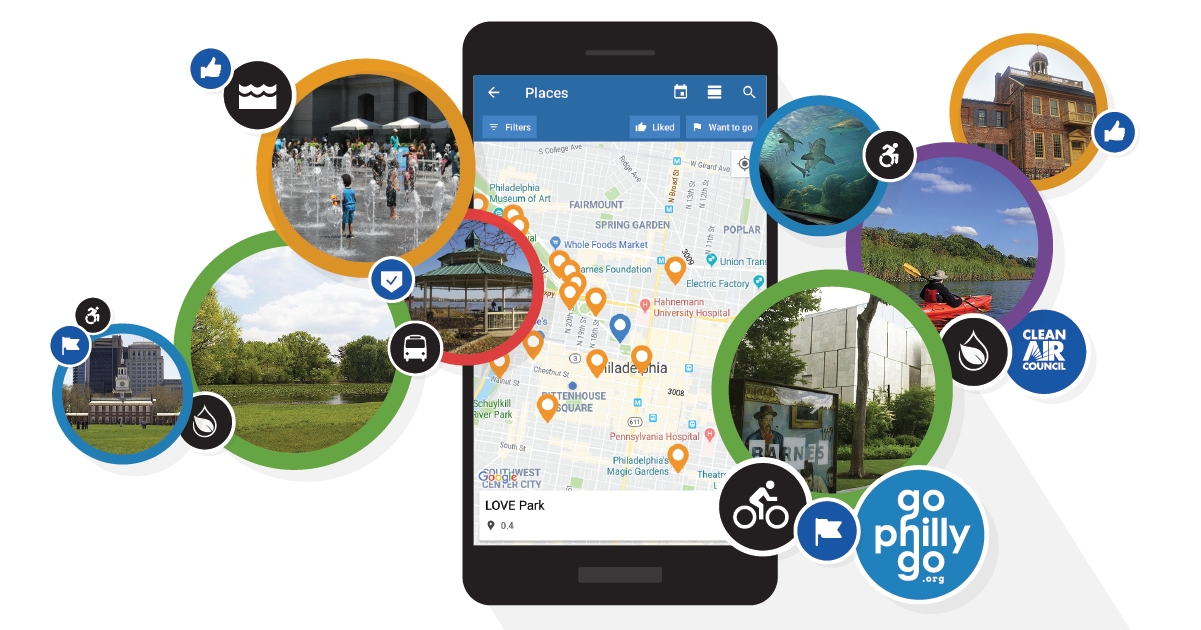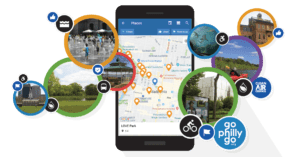
Philadelphia, PA (August 21, 2018) — Since 2015, GoPhillyGo.org has helped people get around the Greater Philadelphia area without a car. Now it’s better than ever with a new app that helps you discover the region.
GoPhillyGo is a project of Clean Air Council and funded by a grant from the William Penn Foundation. The free trip planning site can take you anywhere in the Greater Philadelphia region, including Delaware and New Jersey, without a car. GoPhillyGo gives you directions for biking, walking, taking public transit and is the only multimodal trip planner in the Philadelphia region that allows you to combine any of these modes into one trip.
There are always things to discover in the Philly region, and the new app makes it even easier to find out what’s near you and how to get there. Open the app, and allow GoPhillyGo to use your location to generate a list of nearby places to visit.
Kathryn Killebrew — project technical lead, and Azavea software developer — says “We’re excited to be offering a new GoPhillyGo Android app to complement https://gophillygo.org. You’ll discover fun and surprising things around you, including nature centers and family-friendly events. In building this app, Azavea continues its commitment to contributing open source technology that makes a positive social and environmental impact, and I’m glad to have taken part.”
Turn on Notifications, and the GoPhillyGo app will tell you what destinations are nearby. Users can filter search results by activity type and accessibility. Categories focus on Nature, Exercise, Educational, Cycling, Hiking, and Water Recreation. You can filter for wheelchair accessibility. You can organize your results by tagging them as Been, Want To Go, Not Interested, or Liked. And each destination listing includes the activities you can do there, a map, their website link, and — of course — GoPhillyGo.org’s directions on how to get there without a car. Walk, ride, and bike with the help of GoPhillyGo.
Nick Zuwiala-Rogers of Clean Air Council says “Transportation is the leading cause of greenhouse gas emissions in the U.S., and Clean Air Council is committed to reducing pollution from private vehicles. Our goal is to make it easier to get around without a car, and the GoPhillyGo app is an important part of that effort.”
Take a look for yourself. Screenshots of the app are available here.
The initial release is Android-only, with an iPhone version planned for the future.
GoPhillyGo.org. Your destination ahead. Your map to getting there.
Clean Air Council is a member-supported environmental organization serving the Mid-Atlantic Region. The Council is dedicated to protecting and defending everyone’s right to breathe clean air. The Council works through a broad array of related sustainability and public health initiatives, using public education, community action, government oversight, and enforcement of environmental laws.
PHILADELPHIA, PA (June 4, 2018)- Clean Air Council joined other advocates testifying at City Council in support of the proposed changes to Spruce and Pine Streets in Center City. The project would include protecting intersections and moving the bike lane to the left side of the road where there is a smaller blind spot for drivers. These changes would increase safety and make non-motorized travel along these streets more comfortable and enjoyable. Read the Council’s testimony below to understand why it supports the proposal now, and what it would like to see in the future.
Thank you for the opportunity to present testimony on behalf of Clean Air Council today. My name is Nick Zuwiala-Rogers and I am the Transportation Program Director at Clean Air Council. My work includes promoting sustainable modes of transportation like public transit, walking, and cycling.
Clean Air Council is one of the Philadelphia region’s oldest environmental organizations, serves thousands of members in the city, and has a mission to protect everyone’s right to breathe clean air. The Council supports the proposed project on Spruce and Pine and the associated bills to change parking along these roads, and believes it will help improve air quality in Philadelphia.
According to the U.S. Energy and Information Administration (EIA), the transportation sector has produced more carbon pollution than any other sector since 1979. The EIA has cited the country’s over reliance on single-occupancy vehicle travel and a failure to prioritize non-driving modes of transportation as having a profound impact on this result. Philadelphia needs to do better at prioritizing other modes of transportation like walking, public transportation, and bicycling, and this project offers an opportunity to do that.
Due to the congestion that this City Council has noted recently, center city has some of the worst localized air quality in the city. Therefore, increasing the number of people getting around without using a car should be a priority for this Council. Increasing the safety and comfort of cyclists and pedestrians is the only way to make that happen.
Protected bike lanes are a proven solution for making all road users safer, and getting more people comfortable biking, thereby increasing mode share away from congestion-creating automobiles downtown. A Federal Highway Administration study found 96% of cyclists feel safer riding in a protected bike lane, and safety for cyclists and vehicles improved in nearly every aspect where flex posts or parking protected bike lanes were installed. A physical separation reduces traffic speeds, calms intersections by reducing the turning radius and forcing slower speeds, and creates a shorter crossing distance for pedestrians. I understand that is not what is proposed today, but I should be clear that physical protected bike lanes are ultimately what the Clean Air Council supports.
While this project does not go as far as creating the protected bike lanes that should eventually be installed on these roads, the protections at intersections and the move from right to left side of the street offer key incremental changes that will make road users safer on Pine and Spruce Streets. Importantly, the protected intersections that are a part of this project would help to prevent crashes like the two last year that ended fatally for one person, and with nearly the same result for another. The move to the left side of the road will decrease the space that a cyclist is in a vehicle’s blind spot, especially trucks which are so deadly.
These two roads are the main arterials across center city for cyclists, and are two of the most used bike lanes in the city. The current design is frankly way behind the times and way behind where a city like Philadelphia needs to be with its infrastructure. These safety improvements are not just needed, they are long overdue, and Clean Air Council strongly urges you to support the proposed bills in front of you today.
Thank you for the opportunity to speak with you this afternoon, I’d be happy to take any questions now or discuss any of these matters more with you outside of this meeting.
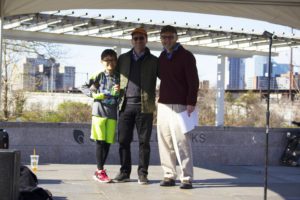
The Clean Air Council is celebrating commuters and employers all over Philadelphia this year with the 2018 Clean Air Commute Awards! Companies and employees that have been nominated have touted their best sustainable commutes and commuting benefits, and while we are excited to have so many great nominations this year, only two can win. Read more about the winners of the Clean Air Commuter and Clean Air Employer Awards below!
Clean Air Commuter Winner- Christopher Johnson, Director of Technology, The Green Program
Christopher Johnson is the epitome of a dedicated commuter with a commute from Mount Airy to City Hall by bike everyday. Before Christopher started biking, he took the commuter rail to Center City, finding a few minutes to walk during his mornings and evenings, but after hearing about the Love to Ride Challenge, a month-long biking challenge in October 2017, he jumped on his uncle’s bike to get in shape and save money.
Today, Christopher bikes to work from his home in Germantown and uses the opportunity not only to get to the office, but work towards personal goals!
“Love to Ride was a cool opportunity to challenge my own ability, get better at biking and taking care of my bike, explore my city, and bond with my co-working fam.”
Nominated by a co-worker, Christopher’s dedication to commuting is noticed by his office and the Clean Air Council. In honor of his hard work, Christopher has won a gift card to his local bike shop. Congratulations Christopher!
Clean Air Employer Winner- Kieran Timberlake
Kieran Timberlake, an architecture firm based in Northern Liberties, has been supporting sustainable commuting for over 10 years! Employees can sign up to use pre-tax dollars for transit passes and other commuting options through Wageworks. Kieran Timberlake also makes it easy for employees to bike to work knowing they will have a secure area to store their bikes and showers to freshen up before heading into the office.
“One of the reasons we chose to locate our studio in Northern Liberties was so our staff could travel easily by bike and public transportation each day.” says Carin Whitney, Communications Director at Kieran Timberlake, “This has had a huge impact on everyone’s health and well-being and lets us be good stewards of the environment.”
The benefits provided by Kieran Timberlake exhibit how easy it is for companies to increase retention, reduce their carbon footprint and save money!
Clean Air Council is excited to recognize Kieran Timberlake as our Clean Air Commute Employer of 2018!
Want to learn more about how you can win next year? Clean Air Council provides free services to help you bring benefits to your office with programs to help you save money and promote sustainable commuting. Email Kamali Alloway kalloway@cleanair.org or call 215-567-4004 ext 131 for more information.
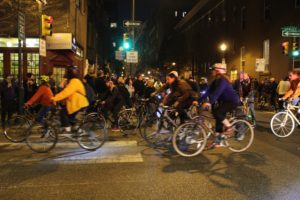
City Council unanimously passed two ordinances today allowing the Department of Streets to designate two bike lanes and an ordinance removing parking along the 8200 block of Torresdale Avenue in Northeast Philadelphia where the Pennypack Trail crosses.
This is a small step toward achieving the Mayor’s campaign promise and Vision Zero plan for 30 miles of bike lanes. So far there are two miles. The bike lane along Race Street will be protected between 8th and 6th Street, and continue as an unprotected lane between 6th and 5th.
The second bike lanes will be installed along Island and Enterprise Avenues in Southwest Philadelphia. Councilman Johnson issued this statement to Clean Air Council on the importance of this bike lane and his thoughts on future trail connections in his district:
“This bill is part of the ongoing collaboration between my office and OTIS to advance Vision Zero goals. My priority is making city streets safe and inclusive. This particular proposed ordinance is the result of collaboration between my office, the Philadelphia International Airport, and community and advocacy groups to improve street safety in Southwest Philadelphia.
I believe bike lanes are beneficial to the city as a whole and this will help cyclists commuting in Southwest. We have received support for the bill from the Bicycle Coalition of Greater Philadelphia and community groups, who were consulted during the bill’s drafting. In cases like this one, where there are not the same space constraints and traffic or construction levels you have in Center City, there’s more opportunity for solutions that work for everyone.
In terms of the East Coast Greenway, my mind goes immediately to the Schuylkill River Trail and our work to connect South Philadelphia and Southwest Philadelphia portions of the trail between Grays Ferry and Bartram’s Garden, as well as fill in the missing links of South Philadelphia to expand access to the trail. I occasionally bike the Trail myself and I understand firsthand the importance of safety while cycling in the streets as well as expanding our greenways.”
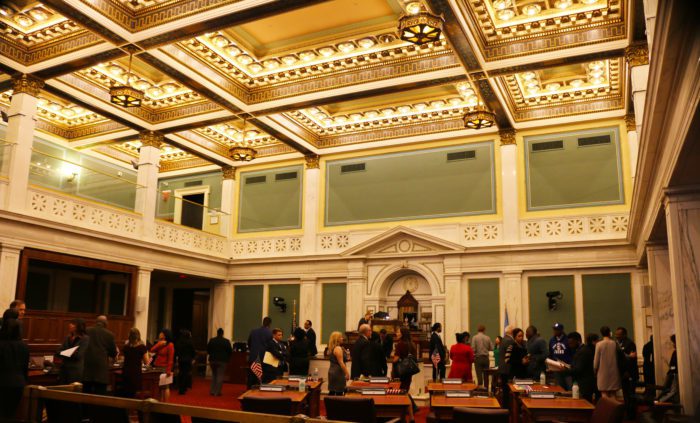
On Thursday, Councilman Mark Squilla, Chair of the Streets and Services Committee, introduced three bills on the Council floor proposing two new bike lanes, and eliminating parking along Torresdale Avenue where the Pennypack Trail crosses in Holmesburg.
This came a day after the Streets and Services Committee moved forward on the bills. According to Plan Philly, City Spokesman Mike Dunn told them in an email that he hopes the lanes will be open by the end of the year.

Race Street in Chinatown
One of the proposed bike lanes would be installed along Race Street between 8th and 5th streets in Chinatown. This particular corridor is heavily trafficked, especially during rush hour, with vehicles headed toward the Ben Franklin Bridge. Race Street turns from three to four lanes that are not clearly marked, adding to potential driver confusion.
The new lane would be parking protected from 8th to 6th, and would also create a much safer connection between Chinatown and Franklin Square, which is one of the only green spaces in the neighborhood.

Race Street at 8th Street looking East
The second bill is to install non-protected bike lanes in both directions along Island Avenue and Enterprise Ave in Southwest Philadelphia near the airport. These lanes will allow cyclists who work in this business and industrial area a safe path from nearby transit stops like the Eastwick Regional Rail Station.
The third bill, proposed in committee by Councilman Henon, removes parking along the 8100 block of Torresdale Avenue in order to allow Pennypack Trail users a clear place to cross the road. This is a wooded stretch of Torresdale Avenue is a key crossing point of the 14.4 mile trail that runs from Huntingdon Valley in Montgomery County all the way to Holmesburg in Northeast Philadelphia.
We spoke with Councilman Squilla briefly outside City Council chambers. “Councilman Henon introduced a bill, and we’re strongly in favor of the bill to allow the trail to continue,” Councilman Squilla said.” “I think it’s a great way to have more open space.”
All three of these are key to the success of Philadelphia’s Vision Zero plan. Safe connections like the Pennypack Trail at Torresdale Avenue will allow people to pursue alternative modes of transportation, and ease the pollution and congestion cars produce every day.
“This just lends the City’s upward motion to keep people who have different modes of transportation and ways of getting to different locations through this trail connector which is a great thing for not only the City but hopefully throughout the Commonwealth,” Councilman Squilla said. “Any time you can have dedicated trails, and people where they are put in a place where it’s safer to transverse, it definitely will help with our plan for Vision Zero.”
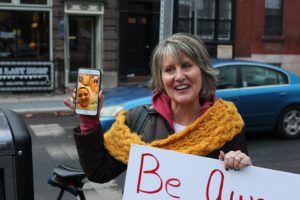
Exactly 17 days passed since Emily Fredricks was struck and killed by a private garbage truck while riding in the bike lane along Spruce Street before another cyclist was again struck by a turning truck while riding in a bike lane. This time the crash occurred near 13th and Pine Streets, just a couple blocks from where Fredricks was killed, and is once again igniting the call for more protected bike lanes throughout Philadelphia.
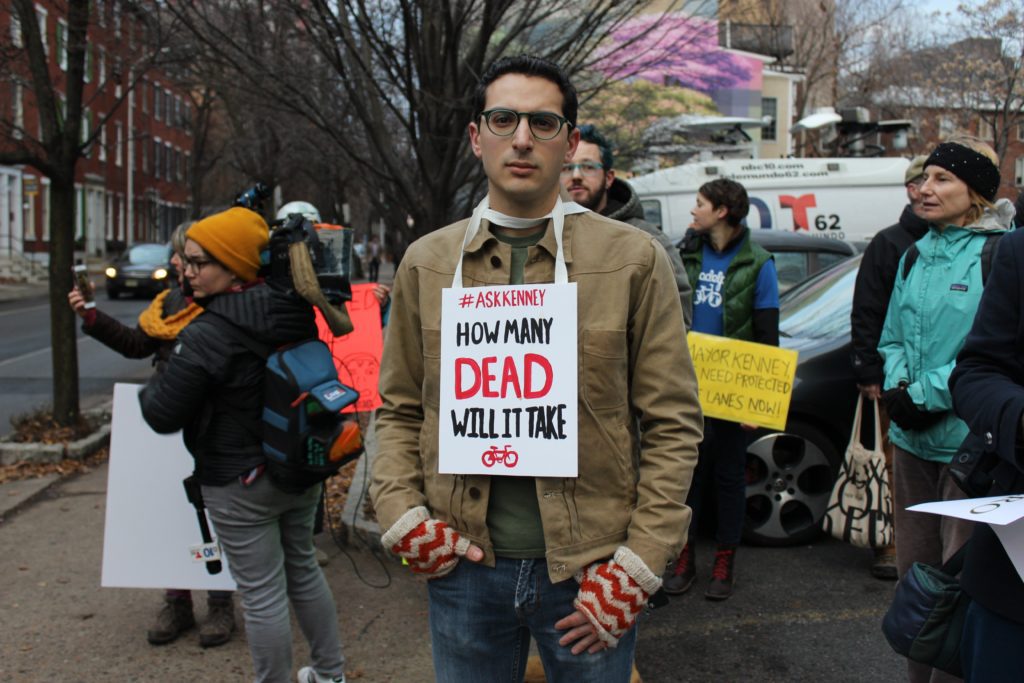
This morning, over 100 people gathered today to again form a human barrier between traffic and the bike lane along 13th Street, and show support for Becca Refford, 24, who was commuting to work when she was hit. Refford waved and smiled at the people who made the human bike lane from her hospital bed via Facetime.
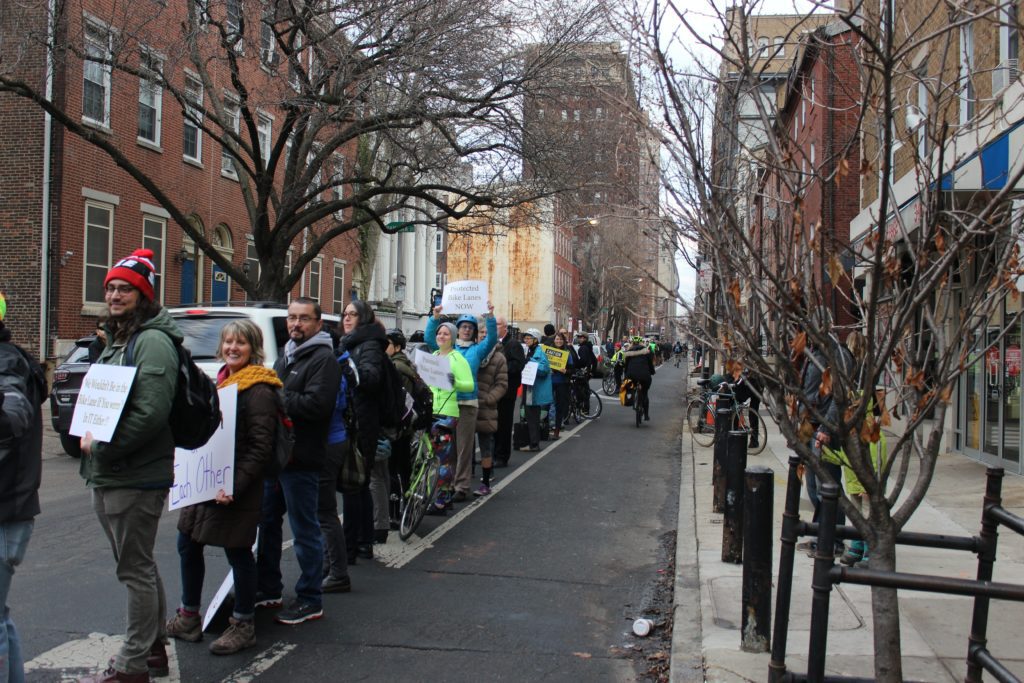
Another serious crash so soon after the death of Emily Fredericks should make clear that paint-buffered bike lanes are not good enough protection on the most used, high traffic streets in Philadelphia.
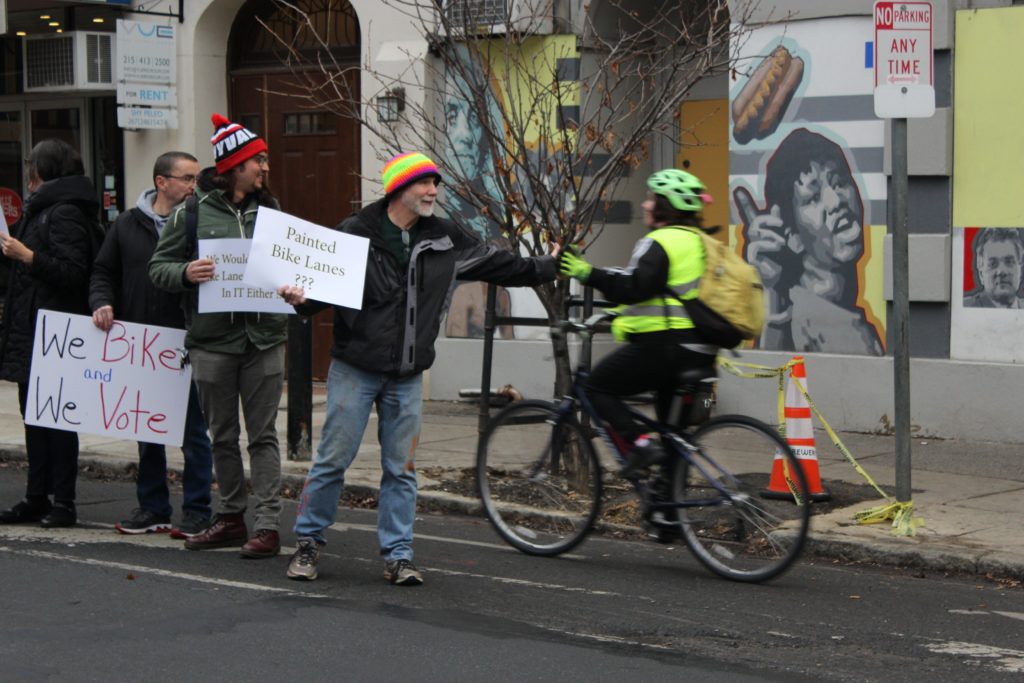
Last week, the City took a small step by committing to a short section of protected bike lanes on South Street and 27th Street near the South Street Bridge. Unfortunately this is a compromise from the original plan to include a protected bike lane along Lombard Street as well.
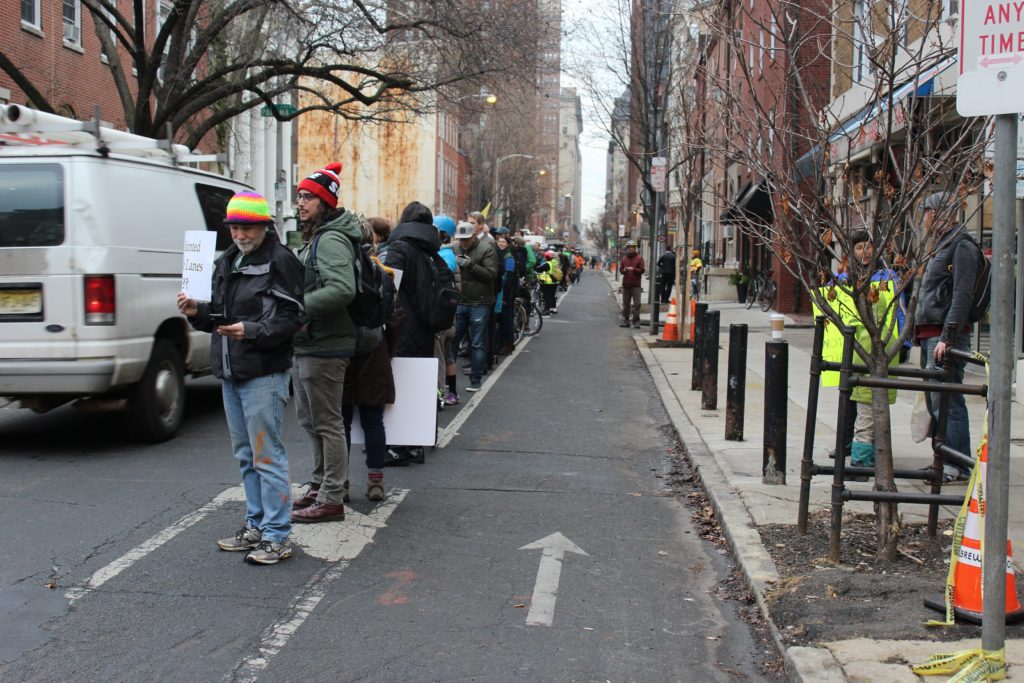
Spruce Street, Pine Street, Lombard, and 13th Street are some of the most highly traveled bike lanes in Philadelphia. It is important that these roads be upgraded from lines of paint to physical barriers, the past three weeks have clearly demonstrated the need. Call Councilmen Kenyatta Johnson and Mark Squilla to thank them for the small addition to the City’s protected bike lane network, and demand that they take further steps to rapidly install protected bike lanes on all of center city’s bike lanes.
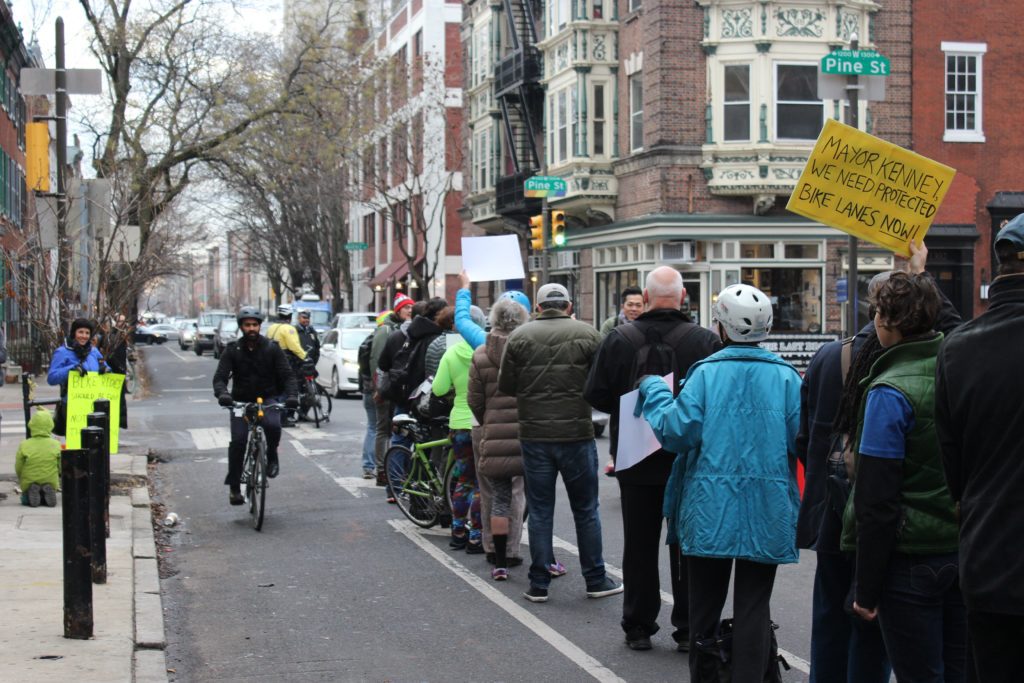

Philadelphia has the highest rate of traffic deaths per capita in the US. According to a National Highway Traffic Safety Administration report using data from 2015, six people for every 100,000 residents died in a traffic related incident. That’s over three times higher than Boston, and more than twice as high as New York City. Cyclists and pedestrians make up 45% of those killed in these traffic incidents.
It’s important to acknowledge these are not accidents, but instead preventable crashes that need to be addressed immediately. Sadly, action will come too late for Emily Fredricks who was killed by a private garbage truck as she rode in the bike lane along Spruce Street last week.
Cyclists who spend any amount of time commuting through Center City know this heavily trafficked area can be extremely dangerous. According to the Bicycle Coalition, a 2015 study counted 212 cyclists per hour passing through 13th and Spruce, just two blocks away from the crash. Emily’s death shows that painted bike lanes no longer meet the demands of increased bicycle traffic in this section, and protected bike lanes must be installed along Spruce and Pine Streets to prevent future fatalities.

How to protect cyclists along Spruce and Pine was the first topic discussed at a recent public meeting hosted by 5th Square, Bicycle Coalition of Philadelphia, and Urban Consulate. A panel of guests including Michael Carroll, Deputy Managing Director of the Philadelphia’s Office of Transportation and Information Systems (OTIS), discussed a recent trip to Copenhagen where participants learned how that super bike friendly city operates.
However, after the panelists introduced themselves, Carroll felt the need to discuss the death of Emily Fredricks, and set the record straight on the city’s plan to add protected lanes along Spruce and Pine.
“There’s a couple things I’d like to see cleared up about that,” Carroll said. “Just to be clear there was never any point in design or plan to put any real kind of protection on Spruce and Pine.”
Carroll told the crowd of about 100 people that OTIS had been examining the possibility of protected lanes along those streets, but were in the extremely early stages of planning and securing grant money last year when news leaked to the public that they were looking into this.
“That information wasn’t really intended for broad public consumption but as things turned out it came out to the public that those were the two streets we were looking at, and that came back to the neighborhood,” Carroll said. “A lot of the folks in the neighborhood were upset.”
That outcry ultimately led to the plan being put on the backburner, and OTIS looked elsewhere for other areas that may have less resistance. According to Carroll, the administrative work to get a bike lane installed takes extremely long, and even if there was no resistance against Spruce and Pine, installation of protected lanes would not have begun until next year.
“From our perspective, we’ve got 2,500 miles of streets to look at, and there’s a lot of other candidates that were on that map that we felt like were better uses of our resources at that time to try and put protection in,” Carroll said. “Even if we had programmed those for installation, if we did find a clear path forward, this project would not have started until the Spring.”
Carroll did admit that more funding may have have helped avoid this tragedy.
“This is an instance where under more ideal circumstances, if money was available sooner, maybe we could have avoided a tragedy, but I don’t know that for a fact.” Prior to this incident, Philadelphia was securing funding and developed a plan to make sure money and ideas are available.
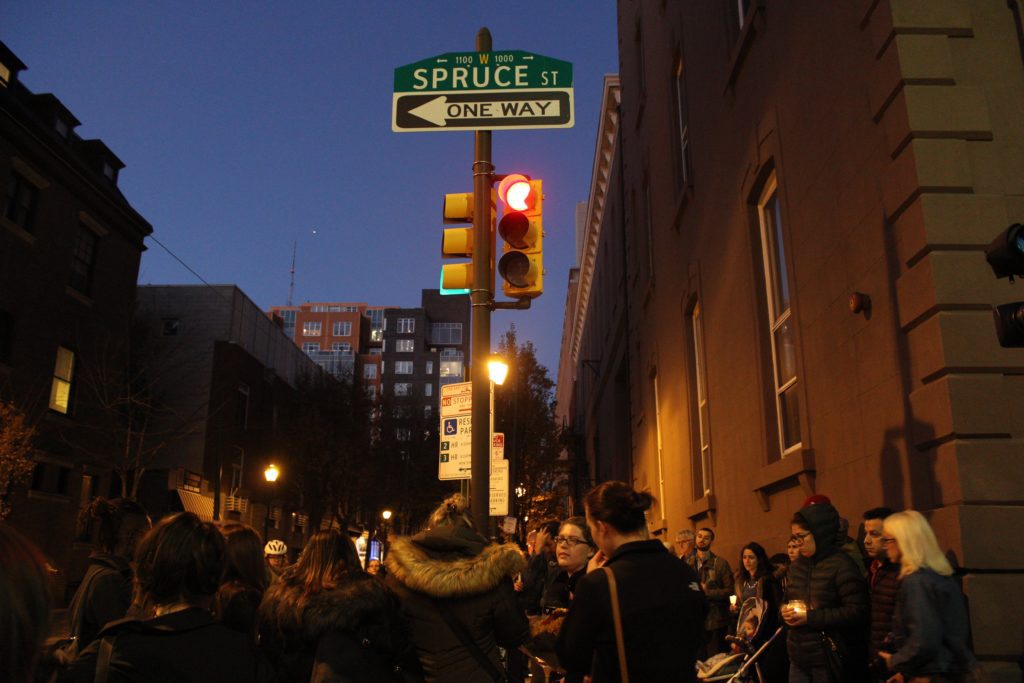
The city’s Vision Zero efforts include a plan to install 30 miles of protected bike lanes during Mayor Kenney’s administration. So far there are two miles. That leaves a lot of work to do, so the time is now for the Mayor’s office and City Council to move quickly on advancing these projects. The Vision Zero Task Force was created, and charged with forming a three year action plan. This plan was released earlier this fall, and you can read more about it here. The plan garnered plenty of local media attention and public support but so far little action from city government, specifically city council who since 2012 has had control over the implementation of protected bike lanes on city streets.
The last thing cyclists in Philly need is their safety in the hands of politicians, and that is exactly what is happening. The Office of Transportation and Infrastructure Systems (OTIS) needs to be in charge of these decisions, and make pedestrian and bicycle network development one of their key initiatives.
Perhaps a lack of funding for protected bike lanes is the problem? It’s not. In fact, funding has been secured on a state and federal level for pedestrian and cycling infrastructure. In March 2016, the city announced they had secured $2.67 million in federal funding with another $500,000 in local contributions to fund five projects under the “Transportation Alternatives Program” (TAP). The plan for cyclists is outlined in one of the projects. The press release states:
The final project, “Safe Spaces for Cyclists: Build a Protected Bike Network”, will include a mix of converting existing bicycle lanes into protected facilities and adding new protected bicycle lanes by adding flexible delineator posts to clearly separate vehicle and bicycle space in the right of way. The project also will include striping and signage in high priority bicycle corridors throughout the City.
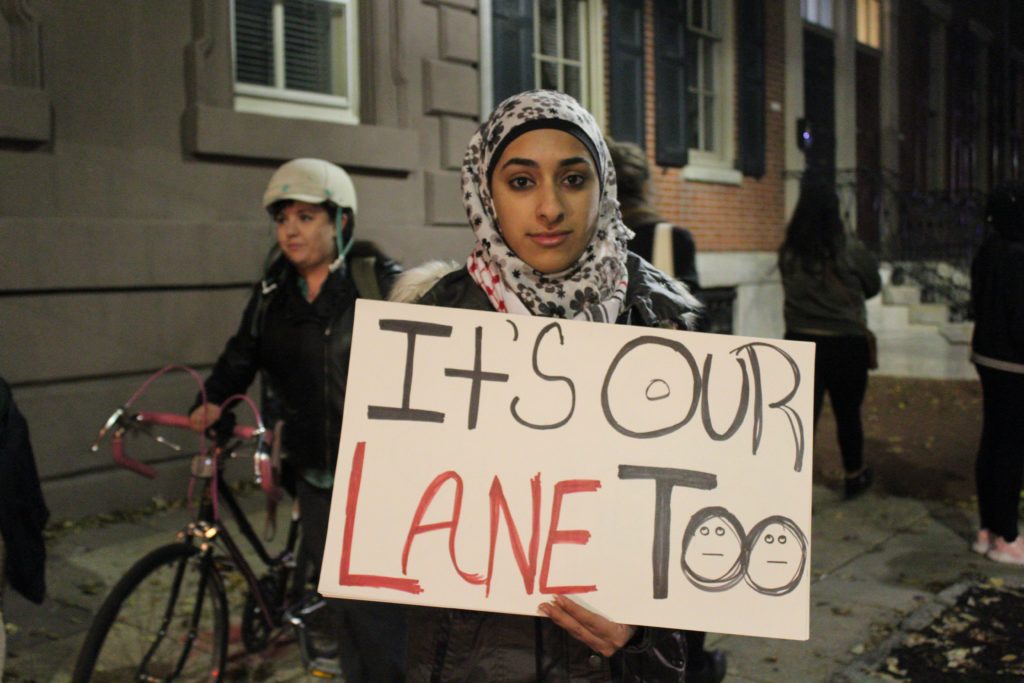
The money is there, the laws are written and plans have been drawn, so why are there still only two miles of protected bike lanes in Philadelphia? The problem is the overly politicized process of road safety. City council is not only guilty of inaction, but in some cases, council members work against the implementation of protected bike lanes under the guise of community outcry.
In 2011, Councilman Greenlee proposed a bill that would require city council to approve all new bike lanes. It was adopted in 2012, and since then council has actively worked against creating protected bike lanes throughout the city. Greenlee is still blocking a bike lane along 22nd street that was proposed in 2014. Councilwoman Blackwell, seems less supportive of the protected bike lane on Chestnut St in West Philadelphia, and recently told the Inquirer, “All I do is get complaints about the lack of access to Chestnut Street.”
Over the summer, Councilman Johnson wrote a letter to OTIS rejecting the planned protected bike lanes on South and Lombard Streets in West Center City. According to the Bicycle Coalition of Philadelphia, residents were concerned that they would not be able to pull into the bike lane to unload their vehicles.
Even the very stretch of Spruce St where Emily was killed has had a protected bike lane proposed and discussed publicly since last December at a Washington Square West Civic Association meeting. Public outcry over convenience has seemingly put the project on the shelf, and the city isn’t guaranteeing protected bike lanes will ever be installed along Spruce or Pine streets. Shortly after Emily’s death, the bike lane along Spruce Street was re-striped. This is simply too little too late, and still allows motorists to cross into the bike lane. City council must take the politics out of protected bike lanes, and start protecting the lives of people who choose to commute by bike.
Please take a moment to write or call your councilperson today. Tell them how important it is to you that they move forward on protected bike lanes, even at the expense of convenience for motorists. Explain that this is literally a matter of life and death in some cases, and you expect quick action from them. Do this especially if you are in Councilman Johnson or Councilman Squilla’s districts. Contact information to city council can be found here.
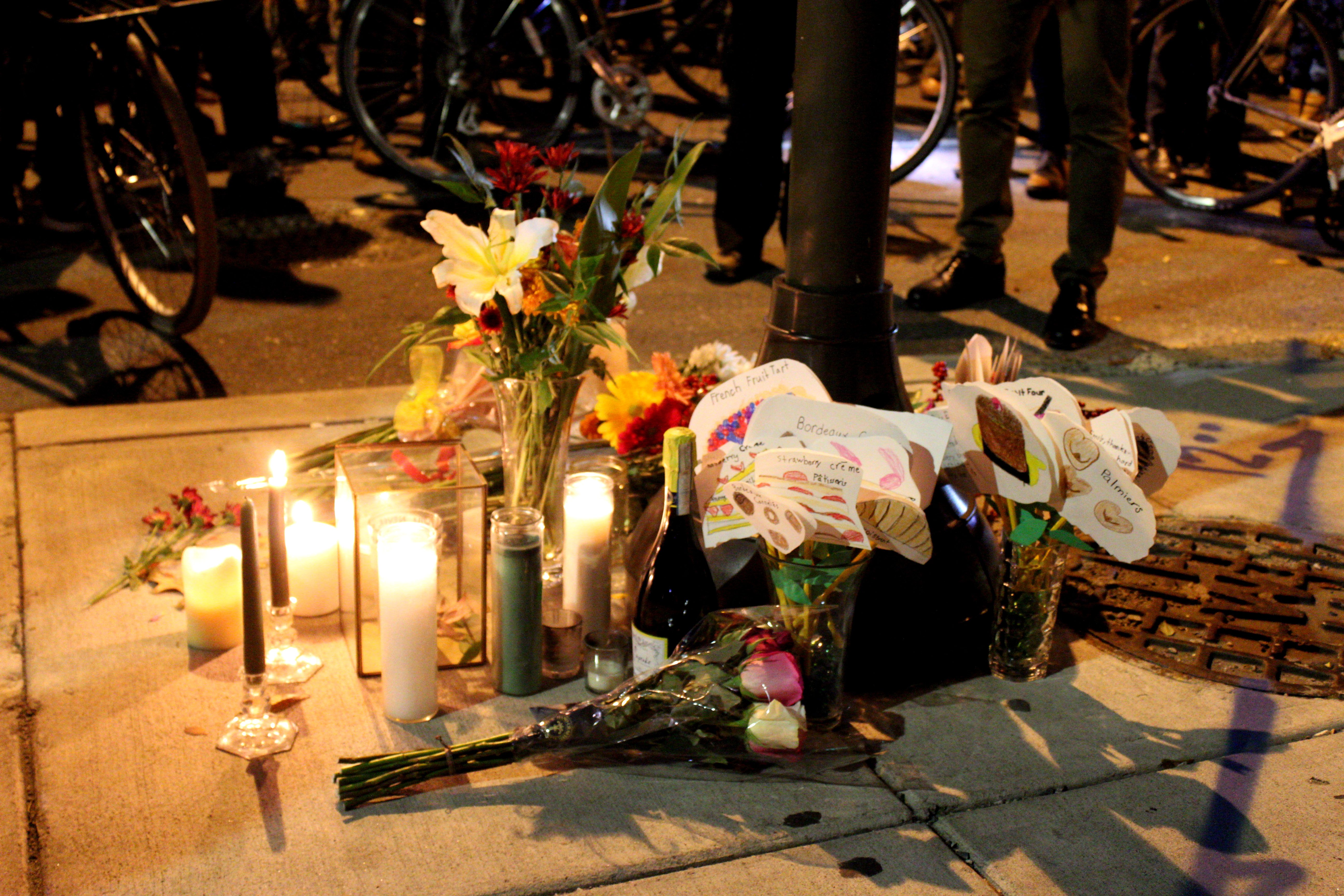
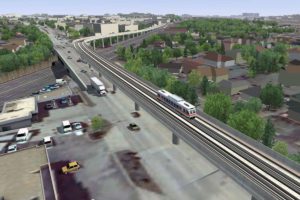
The King of Prussia Mall is the largest suburban mall in the Philadelphia region with 400 stores, and a total of 31,500 people employed at the mall and nearby office parks. The mall is visited by about 68,000 people daily with 5,600 bus riders using six routes to and from the KOP area. Unfortunately, there is currently no rapid transit to get commuters and shoppers to the mall. That is why SEPTA and the King of Prussia business community are planning to extend the Norristown High Speed Line, which skirts the edge of the KOP currently, the rest of the way to King of Prussia.
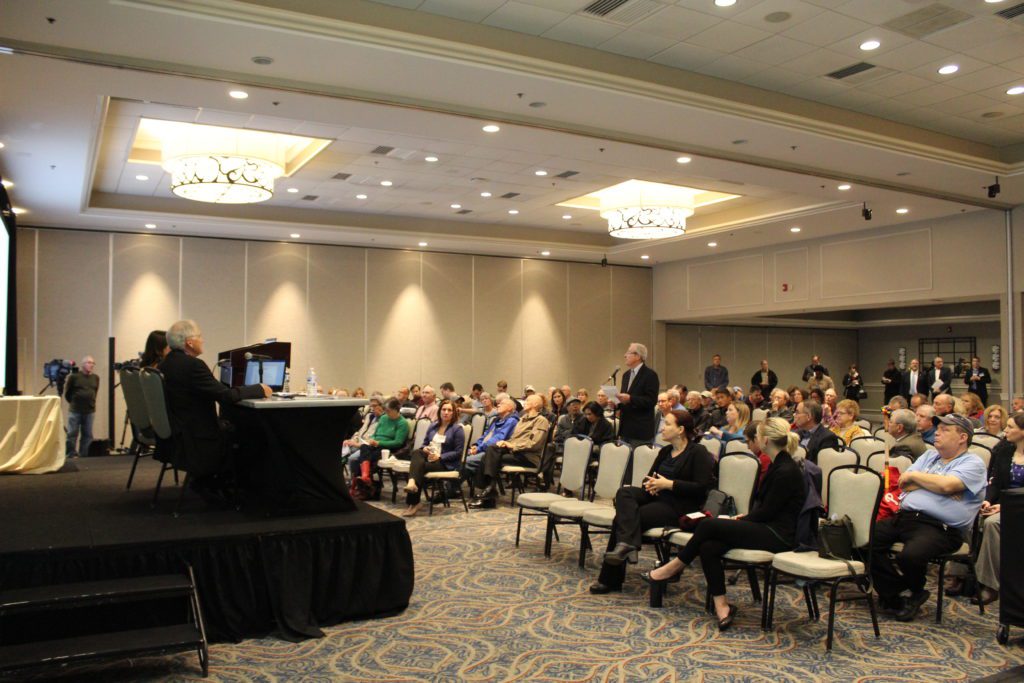
Currently, it can take commuters from Philadelphia as much as two hours to get to work in King of Prussia on the bus, and drivers take an average of 70 minutes – both while navigating the unpredictable beast known as the Schuylkill Expressway. A light rail connection would ease the burden on our transit system and reduce traffic on the already congested expressways near the mall.According to the proposal, the new rail line would take around 40 minutes for the same trip, and offer an appealing option for people who have the choice between driving or public transit.
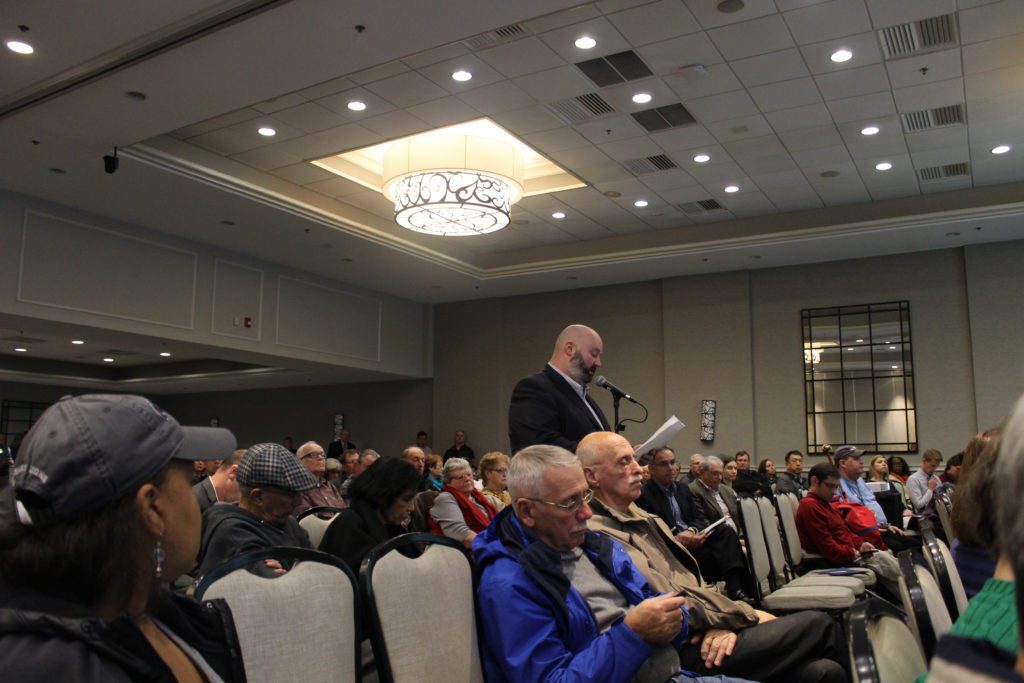
Clean Air Council was there to express its support for the project. Not only does the Council believe it will ease the commutes of transit riders and mall employees, this project will have a ripple effect on the region’s traffic problem. The more reliable transit lines the Delaware Valley has, the more likely commuters will choose to leave the car behind. This will ultimately reduce emissions, and let us all breathe a little easier.
The Council wrote a letter voicing its support, and sent Kamali Alloway, Sustainable Transportation and Special Events Outreach Coordinator, to read the letter aloud at the public hearing. You can read the letter here, and watch a video of Alloway reading the letter below. This project is still in the first stage, and its projected completion date is a few years away. Clean Air Council will keep you updated on developments as they occur.

FOR IMMEDIATE RELEASE
[September 26, 2017 – PHILADELPHIA, PA] Companies from across the Greater Philadelphia Area are signing up and showing their support for bicycling as part of the Love to Ride Philadelphia Challenge. This regional campaign aims to encourage bicycling, foster friendly competition, and inform future decisions around bicycle infrastructure. The Challenge is free and open to all businesses, employees and residents of Philadelphia. The Challenge, in partnership with GoPhillyGo, Indego and the Bicycle Coalition of Greater Philadelphia, runs from October 1st through October 31st, 2017.
The Love to Ride Philadelphia Challenge is about encouraging people to hop on a bike and rediscover the joys and benefits of riding. Workplaces compete by encouraging as many employees as possible to ride their bikes and ride more miles. Competitors who log at least a 10-minute ride are eligible for a chance to win prizes, including a new bike, a three-month Indego membership, a full bike tune-up from Performance Bicycle, gift certificates to museums and local restaurants, and more!
“The American Association for Cancer Research (AACR) is excited to be involved with the Clean Air Council in this city-wide challenge,” said Margaret Foti, PhD, MD (hc), chief executive officer of the AACR. “The AACR is a global organization focused on every aspect of high-quality, innovative cancer research and cancer prevention; thus our staff is looking forward to participating in any activity that promotes health and wellness right here in our own community.”
By supporting the Love to Ride Challenge, businesses will save money, boost productivity and demonstrate their commitment to sustainability. Whether employees are regular cyclists or brand new ones, join the Love to Ride Philadelphia Challenge today by visiting www.lovetoride.net/philly. Registration is open, and participation is free.
Clean Air Council is a member-supported, non-profit environmental organization dedicated to protecting everyone’s right to breathe clean air. The Council has over 8,000 members and works in Pennsylvania, Delaware and New Jersey on public education, community advocacy, and legal oversight and enforcement of environmental laws.

You may have heard that for the month of October, we, along with GoPhillyGo, Indego, and the Bicycle Coalition of Greater Philadelphia, will be celebrating bicycling across Philadelphia with the Love to Ride (LTR) Challenge, a fun, friendly, and free competition to get more people cycling. Increasing bicycling for daily travel is one of the primary goals of our work towards improving air quality in the region. Two of the common cited barriers to cycling include safety and riding, as in knowing where to ride or having other people to ride with. We seek to address these issues by increasing cycling infrastructure, making bicycle trip-planning easy, and advocating for safe streets for all. Read on to learn about our expansive work on bicycle infrastructure, education and advocacy.
Multi-use Trails
 We are a proud member of the Circuit Coalition – a group of non-profit organizations, municipalities, and government agencies that are working together to complete the region’s goal of 750 miles of connected multi-use trails. Currently, the Circuit Trails has over 300 miles complete, with about 100 more miles in progress. We are the lead on some of those in progress miles, including the Cobbs Creek Connector Trail and the Heinz Refuge bike/pedestrian connections.
We are a proud member of the Circuit Coalition – a group of non-profit organizations, municipalities, and government agencies that are working together to complete the region’s goal of 750 miles of connected multi-use trails. Currently, the Circuit Trails has over 300 miles complete, with about 100 more miles in progress. We are the lead on some of those in progress miles, including the Cobbs Creek Connector Trail and the Heinz Refuge bike/pedestrian connections.
Cobbs Creek Connector Trail
The Cobbs Creek Connector Trail will help complete the Cobbs Creek Trail, a key segment of the East Coast Greenway, and will be an important link between communities to recreational areas and historic sites, like John Heinz Wildlife Refuge at Tinicum (JHNWR), commercial hubs and employment centers. The Connector Trail will run approximately 3 miles from Cobbs Creek Trail’s current southern terminus to the JHNWR, spanning 4 main sections. Click here to learn more about the 4 sections of the Cobbs Creek Connector Trail.
Heinz Refuge Bike/Pedestrian Connections
We are partnering with JHNWR to build 3 additional pedestrian and bicycle friendly links in Philadelphia and Delaware Counties to JHNWR and businesses in the vicinity, including Philadelphia International Airport. Click here to learn more about these 3 connections.
Bike Racks
 Secure bike parking is one of the deciding factors on whether a person bikes to work or not. We recognized this several years ago, and since then have been helping businesses with the on-street bike rack permitting and installation process.
Secure bike parking is one of the deciding factors on whether a person bikes to work or not. We recognized this several years ago, and since then have been helping businesses with the on-street bike rack permitting and installation process.
In 2016, we took on a new (to us) bike rack endeavor – the art rack. We were funded by the Penn Treaty Special Services District and the American Street Empowerment Zone to create and install 15 art racks as well as 10 standard inverted-U bike rack and a bike corral in the Fishtown, Kensington, and Northern Liberties neighborhoods. Art racks not only provide secure bike parking to employees and customers of businesses in these neighborhoods, but they also provide an appealing aesthetic that is as much place making as it is bike parking. These have been created by a local metal worker and have been an exciting asset to add to these neighborhoods.
As an extension of our work with bike racks, the Council was awarded an Azavea Summer of Maps fellow, who helped us analyze where bike racks already exist, how much they are being used, where illegal bike parking is happening, and ultimately design a way to predict how many bike parking spaces per employee or customer are needed in different situations.
Do you know a business that is interested in implementing secure bike parking? Have them contact Will Fraser, Sustainable Transportation Outreach Coordinator, by calling 215-567-4004 ext. 123 or emailing wfraser@cleanair.org.
GoPhillyGo
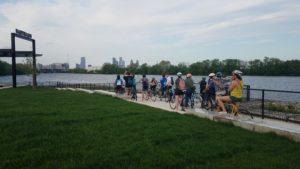 GoPhillyGo.org is the region’s multimodal trip planner that we created to help make it easier to get around the Greater Philadelphia Area without a car. The website lets users plan biking, walking, public transit directions, or any combination of those modes of travel. GoPhillyGo also gives users the option to make their bike trip flatter, faster, or safer by using the customizable options. A very exciting new addition to the website is the Indego bike share functionality. Not only can you check individual station’s dock availability, but now you can plan a trip from start to end with seamless directions of which station to walk to, how to bike to the end station,you’re your final walking leg, just like taking transit!
GoPhillyGo.org is the region’s multimodal trip planner that we created to help make it easier to get around the Greater Philadelphia Area without a car. The website lets users plan biking, walking, public transit directions, or any combination of those modes of travel. GoPhillyGo also gives users the option to make their bike trip flatter, faster, or safer by using the customizable options. A very exciting new addition to the website is the Indego bike share functionality. Not only can you check individual station’s dock availability, but now you can plan a trip from start to end with seamless directions of which station to walk to, how to bike to the end station,you’re your final walking leg, just like taking transit!
As part of GoPhillyGo, we organize bike rides for cyclists of all abilities to environmental centers and nature destinations. Just recently we explored the new Bartram’s Mile, a multi-use trail that goes through Bartram’s Garden, by bike. Subscribe GoPhillyGo’s eNewsletter to stay-up-to-date on our bike rides.
Vision Zero
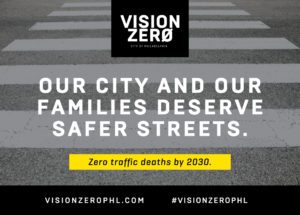 Finally, one of the most important ways we are working in Philadelphia as an advocate for bicycling is through the Vision Zero Alliance and the city’s subcommittees for Vision Zero. Vision Zero is the approach to traffic safety, first implemented in Sweden, based on the notion that no traffic death is acceptable. Cities that adopt Vision Zero policies have the goal of reducing traffic deaths to zero, and Philadelphia recently established their policy, with a goal of eliminating traffic deaths by 2030. The Council works with the City and other advocates to help this goal be met. In addition to Vision Zero’s importance for the dignity of all road users, there is a clear environmental relationship: as the most vulnerable of roadways users, people will not walk or bike for transportation if it isn’t safe.
Finally, one of the most important ways we are working in Philadelphia as an advocate for bicycling is through the Vision Zero Alliance and the city’s subcommittees for Vision Zero. Vision Zero is the approach to traffic safety, first implemented in Sweden, based on the notion that no traffic death is acceptable. Cities that adopt Vision Zero policies have the goal of reducing traffic deaths to zero, and Philadelphia recently established their policy, with a goal of eliminating traffic deaths by 2030. The Council works with the City and other advocates to help this goal be met. In addition to Vision Zero’s importance for the dignity of all road users, there is a clear environmental relationship: as the most vulnerable of roadways users, people will not walk or bike for transportation if it isn’t safe.
What’s Next
Until we reach our Vision Zero goal of zero traffic fatalities and serious injuries, there will be crashes. While many major crashes are reported to police, there are many that are not. Soon we will be debuting a a web tool for reporting minor crashes and close calls. This data can help the City identify areas where improvements for road safety are needed. Remember to always report a crash that results in an injury serious enough to involve medical attention. But, for something minor, help us keep track of when and where those events are happening – stay tuned for Close Calls Philly.
